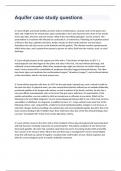Aquifer case study questions
A 5-year-old girl, previously healthy, presents with an erythematous, vesicular rash on the palms and soles and a high fever for several days. Upon examination, she is also found to have ulcers in her mouth. A few days later, the fever and rash resolve. What is the most likely pathogen? correct answers. This presentation is consistent with infection by cocksackie A, an enterovirus. Following an incubation period of three to five days, patients have fever, tender vesicles on their hands and feet, and oral ulcers. Sometimes the rash also occurs on the buttocks and the genitals. The infection resolves spontaneously within three days, and is spread from person to person via saliva, fluid from the vesicles, stool, or nasal discharge.
A 2-year-old girl presents to the urgent care clinic with a 7-day history of high fever to 38.5 C, a maculopapular rash that began on the palms and soles of her feet, red eyes without discharge, and unilateral cervical adenopathy. What other symptom/sign might you discover on further history and exam? correct answersThe constellation of symptoms described suggests Kawasaki disease. The other two classic signs not mentioned are erythematous tongue ("strawberry tongue"), and erythema/edema of the extremities, which is the best answer here.
A 3-year-old boy presents with fever to 103 F for the past week, injected eyes, and a refusal to walk for the past two days. On physical exam, you note conjunctival injection without pus or exudates bilaterally, prominent papillae of his tongue with redness as well as redness of his hands, and feet. He also has a new non-diffuse maculopapular rash on his torso that gets worse with fever. On examination of the swollen extremities, you are unable to elicit any tenderness or effusions in any joints. Which of the following is the most likely diagnosis? correct answersKawasaki disease (KD) is one of the most common vasculitides of childhood. For diagnosis, in addition to fever of > 5 days, patient must meet four of the following criteria: rash, conjunctivitis, unilateral cervical lymphadenopathy, changes in oral mucosa, or extremity changes (redness/swelling). Our patient does not have lymphadenopathy, but often this is the least common finding in KD. If children have fever with fewer than four of the five clinical findings, they can have "incomplete KD" if they meet certain laboratory criteria.
A 5-year-old boy comes to the clinic with a chief complaint of four days of progressively worsening fever and that has been minimally responsive to acetaminophen. The patient complains of sore throat and decreased appetite. His sister had a positive rapid strep test and is now being treated with amoxicillin. Your concern is for Group A strep. What is the next best step in management? correct answersRapid strep test with back-up culture if negative: would provide confirmation of your clinical suspicion and allow for correct diagnosis prior to empiric antibiotic treatment. A 3-year old girl comes to the clinic with a chief complaint of fever (104F) for over a week. Her mom reports that she has been fussy and inconsolable since she became febrile. She has a red tongue, with large papillae, conjunctivitis, a palmar rash, unilateral cervical adenopathy, as well as swollen feet. Given the most likely diagnosis, what is the most important follow-up for this girl over the next few weeks? correct answersEchocardiogram to look for coronary artery aneurysm
because children with Kawasaki disease are at high risk for coronary artery aneurysm formation and should receive an echocardiogram within four weeks of the onset of their illness. Use of IVIG for the treatment of Kawasaki disease has decreased the risk of coronary artery aneurysms significantly. Kawasaki disease is diagnosed when there is a fever plus four of the following: changes in oral mucosa (e.g., strawberry tongue), extremity swelling or redness, unilateral cervical adenopathy, conjunctivitis, and rash. Infectious and rheumatologic causes must be excluded in order to make the diagnosis of Kawasaki disease.
A 65-year-old female presents to your office for a routine visit. She is found to have a blood pressure of 146/96 mmHg. You repeat the blood pressure in her other arm and get 148/92 mmHg. Her pulse is 70 and regular. Her last BP reading was one year ago and was 120/76 mmHg. She has no other medical problems. Her BMI is 28. She states that she likes to walk 30 minutes every other day with her husband and has been doing that for years now. What is the most appropriate diagnosis at this time? correct answersTo diagnose hypertension, two separate readings greater than 130/80 mmHg each time - taken a
week or more apart - are needed. Furthermore, ideally home blood pressure readings in the hypertensive range would be needed to confirm that she does not have white coat hypertension. Because this patient has had elevated blood pressure documented on only one occasion (today), the most appropriate current diagnosis is elevated blood pressure.
If she has a second similarly elevated reading, Stage 2 hypertension may be diagnosed.
Stage 1 hypertension refers to blood pressures between 130-139/80-89 mmHg.
A 68-year-old male was diagnosed with Stage 1 essential hypertension a few months ago and has been working on diet and lifestyle modifications. He has a BMI of 28, mild knee arthritis but no other medical diagnoses. He has been a patient of yours for several years, and returns today as planned. Today his blood pressure is 156/94 mmHg. The remainder of his cardiovascular exam is within normal limits. After counseling the patient, he agrees to start an antihypertensive medication. His creatinine is 0.9, urinalysis is normal, and electrolytes are within normal limits. which of the following is the most appropriate medication to begin in this patient? correct answers· A. Beta blocker
· B. Clonidine
· C. Loop diuretic
· D. Nitrate
· E. Thiazide diuretic




